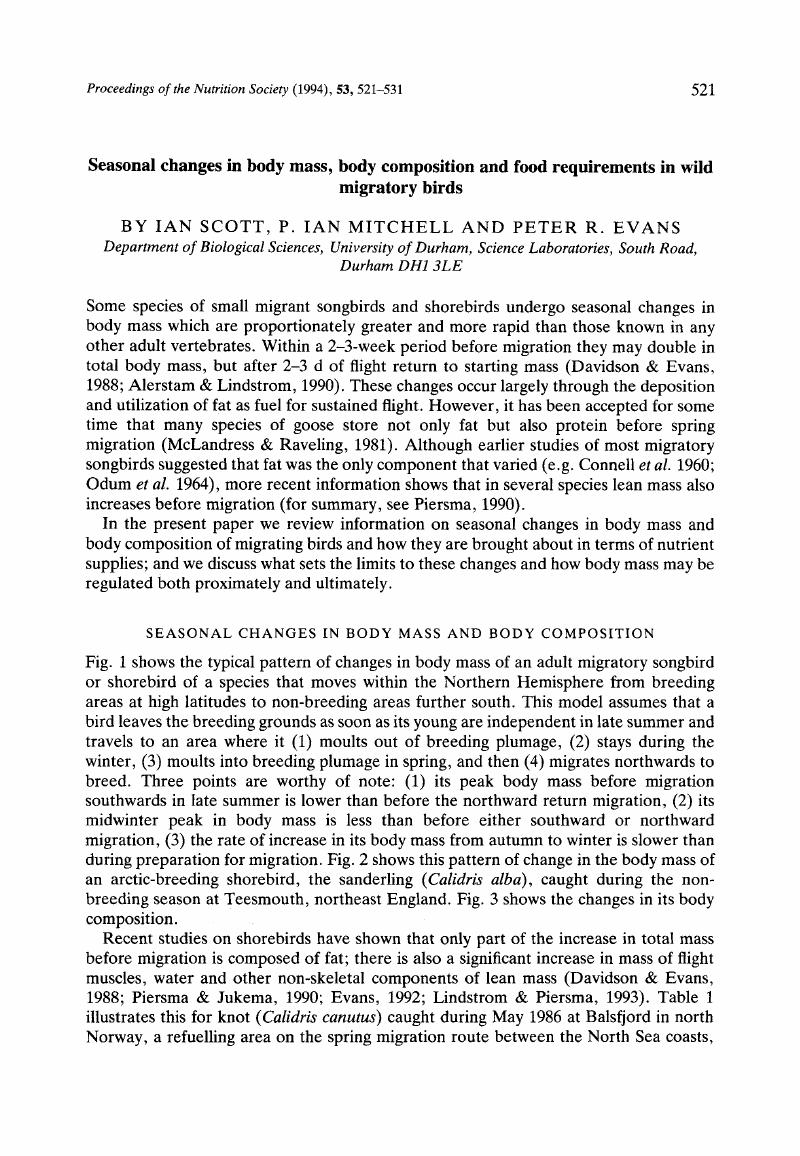Crossref Citations
This article has been cited by the following publications. This list is generated based on data provided by Crossref.
Dänicke, S.
Halle, Ingrid
and
Jeroch, H.
1997.
Evaluation of the non invasive tobec (total body electrical conductivity) procedure for prediction of chemical components of male broilers with special consideration of dietary protein level.
Archiv für Tierernaehrung,
Vol. 50,
Issue. 2,
p.
137.
Zharikov, Yuri
and
Skilleter, Gregory A.
2003.
Nonbreeding Eastern Curlews Numenius madagascariensis Do Not Increase the Rate of Intake or Digestive Efficiency before Long‐Distance Migration because of an Apparent Digestive Constraint.
Physiological and Biochemical Zoology,
Vol. 76,
Issue. 5,
p.
704.
I. AL-Mans, Mansour
2004.
Effects of Captivity on Basal Metabolic Rate and Body Composition in Sanderling Bird Calidris alba.
International Journal of Zoological Research,
Vol. 1,
Issue. 1,
p.
1.
., Mansour I. AL-Mansou
2004.
Seasonal Variation in Basal Metabolic Rate and Body Composition Within Individual
Sanderling Bird Calidris alba.
Journal of Biological Sciences,
Vol. 4,
Issue. 4,
p.
564.
Maillet, Dominique
and
Weber, Jean-Michel
2006.
Performance-enhancing role of dietary fatty acids in a long-distance migrant shorebird: the semipalmated sandpiper.
Journal of Experimental Biology,
Vol. 209,
Issue. 14,
p.
2686.
Artacho, Paulina
Soto-Gamboa, Mauricio
Verdugo, Claudio
and
Nespolo, Roberto F.
2007.
Using haematological parameters to infer the health and nutritional status of an endangered black-necked swan population.
Comparative Biochemistry and Physiology Part A: Molecular & Integrative Physiology,
Vol. 147,
Issue. 4,
p.
1060.
Tinkler, E.
Montgomery, W. I.
and
Elwood, R. W.
2007.
Parent–offspring associations in wintering brent geese: parental investment or mutual assistance?.
Journal of Zoology,
Vol. 272,
Issue. 4,
p.
398.
Seewagen, Chad L.
2008.
An evaluation of condition indices and predictive models for noninvasive estimates of lipid mass of migrating Common Yellowthroats, Ovenbirds, and Swainson's Thrushes.
Journal of Field Ornithology,
Vol. 79,
Issue. 1,
p.
80.
Langlois, Lillie A.
and
McWilliams, Scott R.
2010.
Protein Requirements of an Omnivorous and a Granivorous Songbird Decrease During Migration.
The Auk,
Vol. 127,
Issue. 4,
p.
850.
Lees, John
Nudds, Robert
Stokkan, Karl-Arne
Folkow, Lars
Codd, Jonathan
and
Bartell, Paul A.
2010.
Reduced Metabolic Cost of Locomotion in Svalbard Rock Ptarmigan (Lagopus muta hyperborea) during Winter.
PLoS ONE,
Vol. 5,
Issue. 11,
p.
e15490.
Ruthrauff, D.R.
Dekinga, A.
Gill, R.E.
Summers, R.W.
and
Piersma, T.
2013.
Ecological correlates of variable organ sizes and fat loads in the most northerly wintering shorebirds.
Canadian Journal of Zoology,
Vol. 91,
Issue. 10,
p.
698.
Hou, Lily
and
Welch, Kenneth C.
2016.
Premigratory ruby-throated hummingbirds, Archilochus colubris, exhibit multiple strategies for fuelling migration.
Animal Behaviour,
Vol. 121,
Issue. ,
p.
87.
Elarabany, Naglaa
2018.
A comparative study of some haematological and biochemical parameters between two species from the Anatidae family within migration season.
The Journal of Basic and Applied Zoology,
Vol. 79,
Issue. 1,
Lapsansky, Anthony B.
Igoe, Jennifer A.
and
Tobalske, Bret W.
2019.
Zebra finch (Taeniopygia guttata) shift toward aerodynamically efficient flight kinematics in response to an artificial load.
Biology Open,
Ocampo, Diego
Sánchez, César
and
Barrantes, Gilbert
2020.
Do Different Methods Yield Equivalent Estimations of Brain Size in Birds?.
Brain, Behavior and Evolution,
Vol. 95,
Issue. 2,
p.
113.
Lamb, Juliet S.
Paton, Peter W. C.
Osenkowski, Jason E.
Badzinski, Shannon S.
Berlin, Alicia M.
Bowman, Tim
Dwyer, Chris
Fara, Luke J.
Gilliland, Scott G.
Kenow, Kevin
Lepage, Christine
Mallory, Mark L.
Olsen, Glenn H.
Perry, Matthew C.
Petrie, Scott A.
Savard, Jean‐Pierre L.
Savoy, Lucas
Schummer, Michael
Spiegel, Caleb S.
and
McWilliams, Scott R.
2020.
Assessing year‐round habitat use by migratory sea ducks in a multi‐species context reveals seasonal variation in habitat selection and partitioning.
Ecography,
Vol. 43,
Issue. 12,
p.
1842.
Hidalgo-Rodríguez, Paula
Sáez-Gómez, Pedro
Blas, Julio
Hedenström, Anders
Camacho, Carlos
and
Quinn, John
2021.
Body mass dynamics of migratory nightjars are explained by individual turnover and fueling.
Behavioral Ecology,
Vol. 32,
Issue. 6,
p.
1086.
Brennan, Courtney L.
Boulanger, Emily
Duval, Simon
Frei, Barbara
Gorbet, Ashli
Head, Jessica
Shieldcastle, Mark
and
Jones, Andrew W.
2021.
Two cases of a previously undocumented New World warbler hybrid (Setophaga magnolia × S. ruticilla) in eastern North America.
The Wilson Journal of Ornithology,
Vol. 132,
Issue. 3,
Meissner, W.
Remisiewicz, M.
and
Pilacka, L.
2021.
Sexual size dimorphism and sex determination in Blacksmith Lapwing Vanellus armatus (Burchell, 1822) (Charadriiformes: Charadriidae).
The European Zoological Journal,
Vol. 88,
Issue. 1,
p.
279.
Andrews, CP
2022.
On the use of body mass measures in severity assessment in laboratory passerine birds.
Animal Welfare,
Vol. 31,
Issue. 3,
p.
387.





